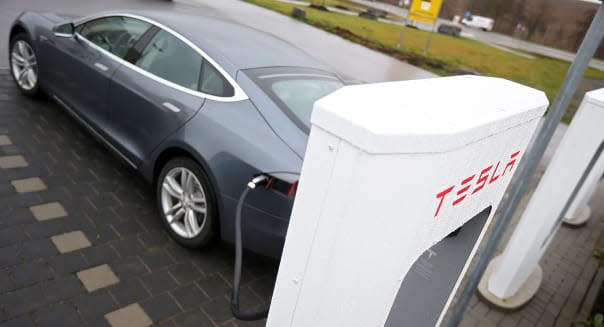Why Consumers Still Shy Away From Teslas: Fires, Costs and Range

Tesla Motors (TSLA) did it again. The maker of luxury electric cars posted another blowout quarter on Wednesday.
However, that only entailed selling and delivering 6,892 of its award-winning Model S sedans. That breaks down to less than 2,300 cars a month, among the millions of cars that sold in the United States during the quarter and tens of millions that sold worldwide.
The Model S is cool, but at the end of the day you're probably not going to get one. Let's go over a few of the obvious and not-so-obvious reasons why car shoppers feel that way.
The Model S is Too Expensive
The plug-in sedans start at $69,900 for the basic model, the one with the smaller battery that needs to be recharged every 208 miles. If you want the model with more range and more kick, that starts at $10,000 more. There are plenty of options that push the average transaction price up to roughly $93,000.
A $7,500 federal tax credit for electric vehicles will take some of the sting out of the purchase the next time you file a return, but the price tag still limits the car's market.
Of course, that's also part of its appeal. Tesla is aiming to have a slightly more economical car hit the market in a couple of years. However, for now you really don't have much of a choice.
The Tesla Fires Are Still Raging
When video of a Model S on fire went viral last year,Tesla quickly let it be known that it wasn't an internal issue that caused the sedan flambe. It was a large piece of debris on the road that ruptured its low-lying battery. Then came another fire. And another.
There were at least three fires last quarter, and earlier this month a Model S caught fire in a Toronto garage. The timing was lousy. The incidents began happening shortly after Tesla began touting its stellar safety rating.
The Model S remains one of the safest cars on the market, but the fires aren't helping its image.
Range Anxiety is Real
One of the things that have been keeping electric cars in check -- beyond the stiff price tags where the high costs of the lithium-ion batteries are only partly offset by the federal tax credit -- is the limited range between charges.
%VIRTUAL-article-sponsoredlinks%Unlike traditional cars, for which gas stations are convenient, quick and everywhere, electric cars need dedicated and lengthy recharging sessions at less ubiquitous sites. Other than the Chevy Volt, these cars need more than traditional power sockets to get juiced up.
For most daily commuting trips, Tesla's range of more than 200 miles is more than enough. However, its limits make road trips or extended outings challenging, if not stressful.
Driving Long Distances Requires Too Many Detours
Tesla's response to range anxiety has been aggressive. It has been building out a network of charging stations. The 79 recharging hubs can restore half of a battery's capacity within 20 minutes. And the charges are complimentary for Model S owners.
To promote these stations, a team of Tesla employees traveled from California to New York City using only Tesla's Supercharger stations. It was framed as a success for electric cars in general, and Tesla in particular. But one aspect of the journey that the car maker probably isn't proud of is that the trek took 3,464.5 miles. The most direct route is closer to 2,790 miles. There's a lot of money to be saved in gas. But time is money for everyone, and perhaps more so for folks who can afford Teslas. Driving an extra 674 miles as Tesla's team did recently probably isn't worth it.
Motley Fool contributor Rick Munarriz has no position in any stocks mentioned. The Motley Fool recommends Tesla Motors. The Motley Fool owns shares of Tesla Motors. Try any of our newsletter services free for 30 days.

